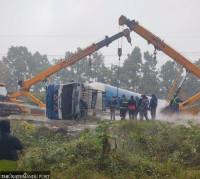National
Who owns the constitution anyway
As those elected to protect the charter assaulted it and those with reservations emerged as the vanguard, analysts call for work towards its wider ownership and acceptability.
Binod Ghimire
In 2015, during the lead up to the constitution promulgation, Nepal’s Madhes-based parties were up in arms. Over 40 people had died in the protests in the Tarai plains.
After squabbling for over seven long years, the “major” parties—the Nepali Congress, the CPN-UML and the CPN (Maoist Centre)—had come together to adopt a constitution. The April-May earthquakes that year had rocked the country, claiming nearly 9,000 lives. The three major parties were in a rush to push the charter, saying the earthquakes had emboldened “their will” to complete the unfinished task.
When the Constituent Assembly announced the new charter on September 20, 2015, Nepali Congress’ Sushil Koirala was the prime minister. But at the centre, in effect, was KP Sharma Oli, elected leader of then CPN-UML in 2014, who played a key role in getting the constitution promulgated.
The new charter was celebrated in Kathmandu and other parts of the country but it was denounced by sizeable sections of the Nepali society. Those who opposed the constitution said various provisions further marginalised them.
Oli was a in hurry to take over the reins; Koirala wanted to get his name written in history books as a leader who oversaw the promulgation of the constitution; and Pushpa Kamal Dahal, the Maoist leader, wanted a vindication that the demand of the “people’s war” that there should be a charter through a Constituent Assembly was finally getting fulfilled, analysts say.
Their interests converged; they refused to give two hoots about the dissenting voices—not even the lives that were lost.
In October 2015, Oli became prime minister with the backing of Dahal’s Maoist party, only to have the rug pulled from under his feet less than a year later.
Dahal and Congress’s Deuba, who was elected party president in March 2016, led the government in turns until the 2017 elections, which then installed Oli in Singha Durbar, making him the custodian of the constitution.
But around three years after assuming office, Oli on December 20, 2020 brazenly assaulted the constitution, which he was elected to protect, by dissolving the House of Representatives.
The subsequent two months were full of uncertainties.
On Tuesday, the Supreme Court, through a mandamus order, reinstated the House of Representatives overturning Oli’s December 20 move of dissolving the House. The Supreme Court order has been hailed largely as historic, for it helped the constitution prevail.
Political and constitutional experts say though the Supreme Court has helped bring Nepal’s politics back within the constitutional framework and saved the constitution from collapsing, it has left more questions for Nepali polity to answer, the foremost being who actually owns Nepal’s constitution.
“The constitution continues to be in danger because of a lack of ownership and increasing attacks on it,” Rajendra Maharjan, a political commentator and columnist for the Post's sister paper Kantipur, told the Post. “The dissolution was an extreme manifestation of Oli’s unconstitutional move. He has been attacking the charter from the very beginning, directly or indirectly.”
According to Maharjan, the recent criticism of Oli by Pushpa Kamal Dahal and Nepal over the House dissolution is a farce because they were equally complicit in Oli’s assaults on the constitution.
After Oli’s House dissolution move, the Janata Samajbadi Party was quick to take to the streets. The party also called Oli’s decision a blatant attack on the constitution and called for protecting it.
On Monday, a day before the Supreme Court passed its verdict on House dissolution, Janata Samajbadi Party chair Upendra Yadav said in Janakpur that they still have reservations about the constitution but protecting it is the need of the hour.
“We had our reservations when the constitution was being pushed and we still have. But this constitution has guaranteed federalism, secularism, inclusion and proportional representation,” said Yadav during a book launch. “That’s why we have to come forward to safeguard the constitution.”
Analysts say the irony over the constitution within five years of its promulgation is uncanny, as those who pushed for it and were chosen to protect it are weakening the charter and those who opposed it are calling themselves the vanguard. This exposes a deep problem, which goes back to the time of its drafting, according to them.
The Constitution of Nepal 2015 is the outcome of a seven-year exercise. Why it took two constituent assemblies was largely because of ever-squabbling parties.
Nepali political parties themselves admit that it was the 2015 earthquakes that brought them together to “adopt” a charter at any cost.
And in that rush, analysts say, the philosophy was missing. Since the objective was to have a charter promulgated, it became a document of compromise with technicalities prevailing over philosophy.
CK Lal, a political commentator and a columnist for the Post, said even the parties who called the Constitution of Nepal “the world’s best” have failed to own it up wholeheartedly.
“The constitution became a stepping stone to power (government) for the then UML, a platform for the Maoists to embrace mainstream politics and all that the Nepali Congress wanted was credit for promulgating the statute,” said Lal.
According to Lal, the present constitution lacks the guiding principle which is the foundation of any constitution.
“Without a guiding principle, the constitution is just a set of laws and bylaws,” Lal told the Post. “The constitution without foundation is weak which can be misused easily.”
The 2015 constitution guarantees some important features like secularism, federalism and republicanism in an attempt to effect socio-economic transformation, but as a whole, it lacks the political philosophy. As a result, it has a more legalistic approach.
“For instance, the American constitution has life, liberty and the pursuit of happiness as its guiding principles. Satyamev Jayate is the guiding principle of the Indian constitution,” said Lal. “But the Nepal constitution is devoid of such ethos.”
Analysts say a constitution must be read in conjunction with the debate in the Constituent Assembly so that the justification of the values incorporated in the charter can be well understood and explained.
This is why lawyers during the hearing against Oli’s House dissolution called on justices to look to legislative intent. The lawyers were arguing that the framers of the constitution had deliberately deprived the prime minister of the right to dissolve the House.
This then raised the question of authorship of the constitution.
Subas Nembang who chaired the Constituent Assembly for both terms and oversaw the entire constitution-drafting process chose not to speak a single word on Oli’s House dissolution decision. A video clip of Nembang had gone viral in which he is heard clearly saying that the constitution does not allow the prime minister to dissolve the House. Agni Kharel, one of the drafters of the constitution who is the incumbent attorney general, was defending Oli’s House dissolution, which the court ultimately called unconstitutional.
Analysts say a constitution can get wider acceptability only when there is authorship and ownership.
In Nepal’s case, both are missing.
It’s the drafters of the constitution who should come forward to explain how, when they decided to guide Nepali society and polity by a set of values through the constitution, there was a corresponding set of reasons.
Analysts say the recent turn of events has exposed the shaky ground on which Nepal’s constitution stood since the day it came into being. However, weaknesses and shortcomings of the constitution could have been addressed had the custodians and those elected to implement it had shown sincerity, according to them.
Many say what BR Ambedkar, who is known as the father of the Indian constitution, once said resonates even in the Nepali context.
“However good a constitution may be, if those who are implementing it are not good, it will prove to be bad. However bad a Constitution may be, if those implementing it are good, it will prove to be good,” Ambedkar said in his final speech in the Constituent Assembly on November 25, 1949.
Ambedkar stressed the need to work towards a social, not just political, democracy.
Dinesh Tripathi, a senior advocate, said constitution writing is one thing, and constitution building is another.
“A good ruler turns a bad constitution into a good one through its positive implementation,” said Tripthi. “However, bad rulers, like in our case, look for loopholes and lacunas to attack it.”
According to experts, a constitution is a living document, and it can be amended as per the need and time. But when the custodians start assaulting the charter, its usefulness comes into question, according to them.
Vijay Kant Karna, a professor of political science at Tribhuvan University, said it was the collective duty of those who championed the cause of the constitution, despite dissenting voices from a large section of the society, to protect it.
“Oli, however, was not the right person from the very beginning for the role to play as the custodian of the constitution,” Karna told the Post. “Oli’s actions show he pushed for the constitution in 2015 only to use it as a means to get to power.”
According to Maharjan, the political commentator, increasing attacks on the constitution could take away the progressive achievements.
“Federalism, secularism and republicanism are salient features of this constitution,” said Maharjan. “Constant pressure must be built for the ownership as well as wider acceptability of the constitution.”




 6.12°C Kathmandu
6.12°C Kathmandu













%20(1).jpg&w=300&height=200)

